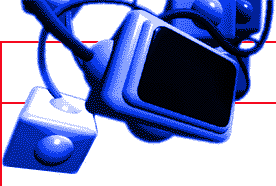|
Space Station - 2020
It is ironic that educational material associated with Space Station 2020 has less to do with space than with people.
When looking for a close parallel to life on board a space station, the closest analogy is probably life on board a submarine or an ancient sailing ship. Consider the similarities: an artificial habitat, designed to sustain human life, contained within a vessel, itself designed to deal with the rigours of its environment. Very limited space, and only items essential to the performance of duties are available. The occupants have a variety of set tasks, which must be performed in a coordinated manner, both for greatest efficiency, and for the survival of the crew. This coordination needs a clear chain of responsibility, an acceptance of the goals of the mission, and an assumption that each crew member knows what is expected of him or her.
In addition, both ship and space station are dependent on an infrastructure which includes communication and supply, but both must be independent, as physical contact with base is likely to be only after prolonged intervals of separation.
Both ships and space stations are technology-driven. In the case of the submarine or sailing ship, it has to be engineered to keep its crew alive for extended periods. However, human beings are very adaptable, and will tend to work around shortcomings in their own provision within the ship. In other words, human beings re-engineer themselves to deal with situations. Once the obvious technological and physical problems have been dealt with, the remainder is to do with psychology; and then technology, once it has proved that it works, fades into the background.
This is quite important to get across to the students. Building the space station has two aspects: Technology and Psychology. The Technology is what fascinates most people: rocket launches, docking of modules, space walks, possible disasters, Man against Space etc - all very attention grabbing. But once the thing is operational, what you have is an industrial facility, which the workers cannot leave in order to go home, added to which is the "minor" complication of weightlessness. So we have to consider the important problems as those which the human occupants either create or bring with them, or are part of the human condition.
Physical Problems:
- Deleterious effects of microgravity
- Lack of space
- Dependency on technology
- Equipment failure
- Waste management
- Prospects of Illness, Injury or Death
Psychological Problems:
- Boredom
- Lack of privacy
- Homesickness
- Relationships with others:
- Peer dynamics
- Professional competitiveness
- Respect for peers
- Anxiety through being in a fragile structure in a hostile environment
- Sensory deprivation
- Overwork
The significant difference between a ship and a space station, is of course that the ship has a clear structure of officers and ratings, with an obvious chain of command. The occupants of a space station will be a small group of highly-trained individuals, each of whom may have a temperament which is unsuited to this traditional structure. After all, it costs a lot of money to put someone on a space station, and they will be there because, for whatever reason, they have beaten someone else to the post. With such highly-motivated and educated individuals, the importance of training together is vital. However, it will also be vital to keep a certain freshness to any established relationships, by not socialising overmuch - if only to avoid running out of jokes!
Students may be asked questions on their own relationships with their peers, when they have the capacity to get away from them - something denied to the occupants of a space station.
Long Time Together
Robert Zubrin in his book "The Case for Mars" actually states that a manned mission to Mars could not function well with a structured "Star Trek"- type set of crew responsibilities. Instead, he favours a situation in which there are generalists, versatile individuals capable of great flexibility. As there are some who say that the only real reason for the International Space Station - now under construction - is in fact preparation for such a mission, is it best to start off with that sort of approach.
Experiences on the Mir Space Station are instructive. In order to avoid conflicts, the cosmonauts tended to avoid disputes by lowering their own emotional levels, so that they stopped "feeling", as it was impossible to get away from someone who had been offended, or who had caused offence. This has caused problems in marriages on return to Earth. Is there a time limit which should be observed in rotation of crews?
Home Comforts
On Skylab, all the atmosphere was stowed on board, and it provided the physical means to keep the astronauts alive. However, not enough attention had been paid to the little things of life, in particular, smells and odours. Before EVA, the astronauts used to wipe the inside of their visors with lemon handy wipes. They were so deprived of smells that it became a ritual to pass these around, so that they could all smell them, and remain in contact with Earth through smell. NASA had carefully programmed their diets, but the astronauts soon started to play around with the programme, saving specially favoured items such as butter cookies, so that they could use them as incentives to get someone to do a job they might not want to do.
Other aspects that will be suggested as lines of enquiry are : the psychological effects of colour - warm v. cool. relaxing v. exciting (this could be extended to the use of colour in political posters) - and their importance in a work environment; "customising" spacesuits; planning of diets for nutrition and as a link with Earth; the importance of the handwritten letter.
The modules will try to deal adequately within their remit with the psychological and technological aspects to the Space Station. We will try to deal with the technical and aforementioned human factors. Both should provide the bases for much stimulating activity.
Warp to the Teachers' Index Page
|





